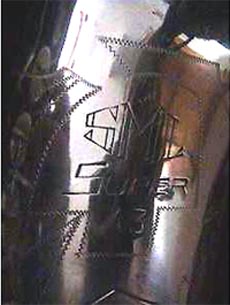In
addition to all these models having "Super" engraved
on the bell (excepting the "Model 49"), this is
truly the transitional horn on the SML model chart from the
Rev. B to the Rev.
C. These horns have:
- "Rat-trap"
keyguards -- until the Super 47 at s/n 65xx or so, then they
have Rev. C sheet-metal keyguards.
- SML logo with two 5-pointed stars engraved on bell starting
in 1947.
- The wire bell-to-body brace of the Rev.
B, that is replaced over this model's life to the heavy-duty
"T" brace of the Rev. C.
- A name on the bell ("Model 49",
"Super 42", etc.) that tends to logically indicate
that the number is the year the horn was produced. This makes
for a more accurate serial number chart -- from 1942 to 1949,
at least :)
Probably the
most significant leap over the Rev.
B is in keywork design. Between the Super 43 and 45, the
famous G#/C#/B/Bb cluster that any SML lover can spot from
a mile away was introduced -- but the switchable articulated
G# didn't appear until the Model 49. The layout of the pearl
keys also appears a bit more in-line with the horn and the
C/Eb keys are more sculpted than the Rev.
B.
I think that
the bell size is actually a bit smaller than the Coleman Hawkins
models, but it does appear larger than a "standard"
Rev. B, meaning there may be bore-size
differences.
Recently,
a gentleman with a Super 42 model sent some pictures my way.
This is a beautiful horn that looks like a "standard"
Rev.
B,
but it has additional keywork: an altissimo D# trill key and
a G# trill key, as well as a working forked Eb assembly. The
additional keywork may indicate that the "Super"
series of horns was intended as a "Super Pro" line
of horns.
I do have some problems with
this categorization of "Super Pro", not primarily
because of the low production of SML, but because of the fact
that the Coleman Hawkins and other
Rev. B models were obviously available
at the same time as the Super 42 through possibly the Super
44 -- and the other Supers lack these features. Things that
support the "Super Pro" hypothesis, though, are
that later Rev. B horns do not have the "standard"
G# cluster and the bell-to-body brace on the Supers and Model
49 is different than that on the Rev. B.
Finally, the owner of the Super
42 & 47 pointed out to me that the necks on these horns
have somewhat different angles, while the bell and body tube
dimensions are the same. IMHO, this is a case of "neck
droop", but I include the information here for you to
ponder.
I
believe that all Supers were only available in silver plate.
I'm more than willing to have someone send me pictures and
prove me wrong :)
|









